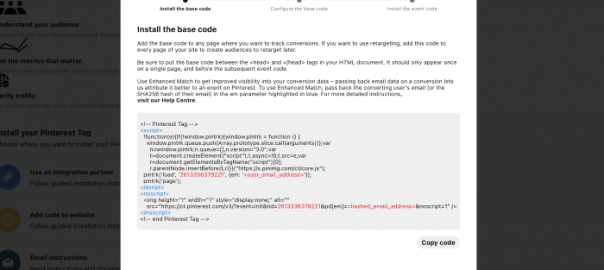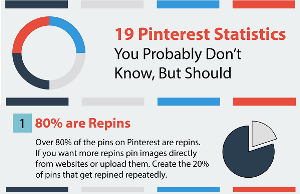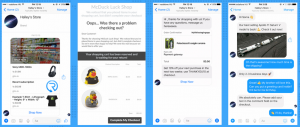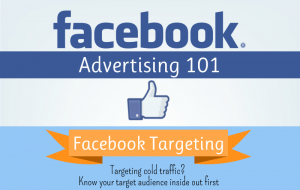We explain why Pinterest advertising is here to stay, what ad formats are available, how much it costs to advertise, how to set up your first campaign and best practice advice.
Pinterest may not have the colossal user numbers to compete with Facebook and Instagram but it’s got one of the most active, engaged user bases around. It also has a natural advantage over most social advertising platforms: people go there specifically to find purchase inspiration.
In this guide, we help you decide whether Pinterest deserves a place in your social advertising strategy and provide all the info you need to get started.
What are we looking at in this article?
The aim of this article is to help you decide whether Pinterest advertising is for you and get you started with your first campaign. To cover all of the essentials, we’ve broken this guide into the following sections:
- Who should advertise on Pinterest?
- A summary of the Pinterest ad formats
- How much does it cost to advertise on Pinterest?
- Are Pinterest ads effective?
- How to advertise on Pinterest
- Pinterest advertising best practices
1. Should I advertise on Pinterest?
Pinterest is a visual social network with excellent engagement and a user base that primarily consists of young, affluent women (although, the gender balance is changing). Pinterest says more than 60% of its global audience is made up of women while 2018 data showed 45% of Pinterest users in the UK were female and 27% male with 55% of users being aged between 18-24 years old.
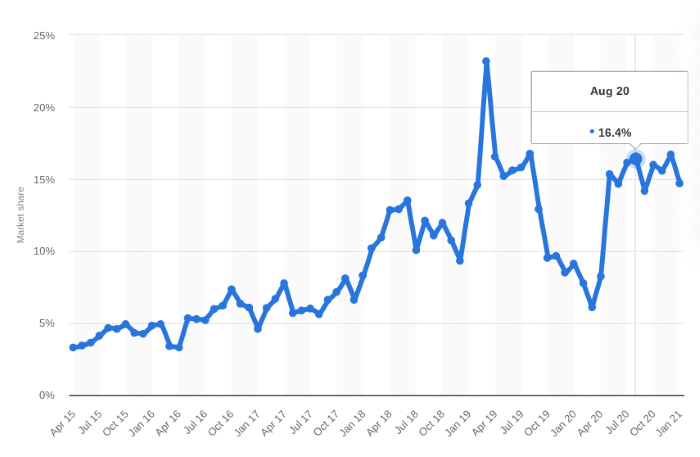
Pinterest usage in the UK was still growing at the start of 2021, despite some volatility with the platform’s Q4 2020 earnings report (PDF) posting a significant jump in revenue and a 17 million boost in user numbers, reaching 459 million active users.

Interestingly, the gender divide appears to be narrowing on the platform but the age demographic remains surprisingly young for a platform that’s been around since 2010. In 2020, Pinterest saw its biggest growth among Gen Z users with a staggering increase of 40% from the previous year so TikTok isn’t the only platform grabbing their attention.
The most important thing about Pinterest as an advertising platform is that users turn to it for purchase inspiration.
Roughly 90% of Pinterest users rely on the platform for purchase inspiration while 85% of Pinners say they use it for planning new projects. Unlike most social networks, Pinterest users are in shopping or inspiration mode when they open the app and this makes them far more receptive to ads promoting products, styles or services that might help them with that next big project – anything from re-modelling their home to planning a wedding for a client.
Here are some examples of the kind of products and services that are great for advertising on Pinterest:
- Fashion & clothing
- Interior design, furniture, etc.
- Crafts
- Life events (weddings, birthdays, etc.)
- Food & diet
- Health products
- Lifestyle products
- Fitness
- Travel
- Sustainable products
- Small business software services
So if you want to inspire purchase decisions among consumers, professionals and small businesses owners, Pinterest is one of the first platforms you should take a look at.
You could be a fashion retailer looking to sell clothes directly to the end consumer, a wedding photographer promoting your services or a software provider targeting creative microbusiness owners with a new mobile accounting app. As long as you can create visually engaging ads, Pinterest can connect you with all of these and more.
2. Pinterest ad formats
You can find a breakdown of all the Pinterest ad formats and their specifications on this Help Centre page. There are currently six formats on Pinterest with Story Pins being the only format that’s exclusive to organic posts. The ad formats available are:
- Static ads
- Video ads
- Max video ads
- Carousel ads
- Shopping ads
- Collections
Most of these ad formats are available for brand awareness campaigns (depending on your settings) but choosing other campaign objectives will limit the ad formats available to you.
Static ads
Static ads feature only one image and this is the default ad format for most campaign objectives (except Video Views and Catalogue sales).
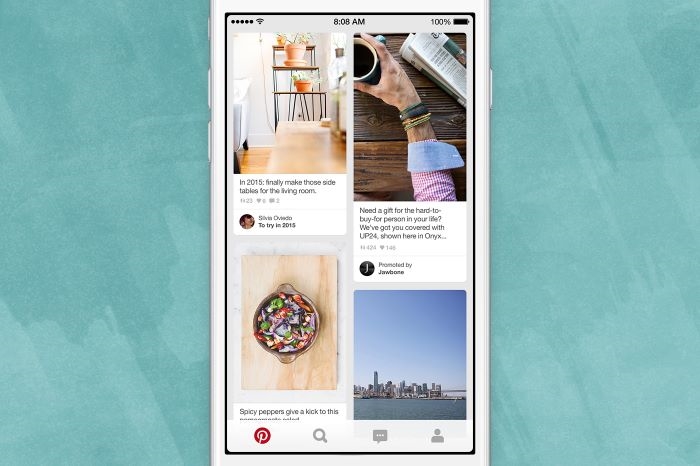
Standard width video ads
Standard width video ads are the same size as regular Pins, fitting into the usual scrolling experience. They’re available for all campaign objectives, except for Catalogue sales. Your footage needs to be at least four seconds long and no longer than 15 minutes but it’s recommended to keep them in the 10-30 second range or shorter. You can find the full specifications here.
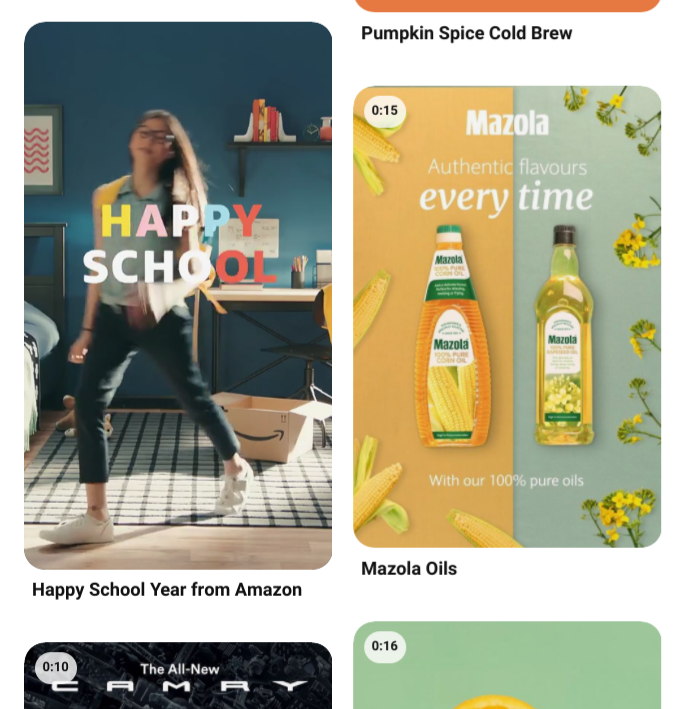
Max width video ads
Max width video ads expand across the entire width of the display on mobile devices with the aim of capturing users’ attention as they scroll through their feed. These are only available as an ad format (you can’t create organic max video posts) and they’re available for three campaign objectives: brand awareness, video views and consideration.
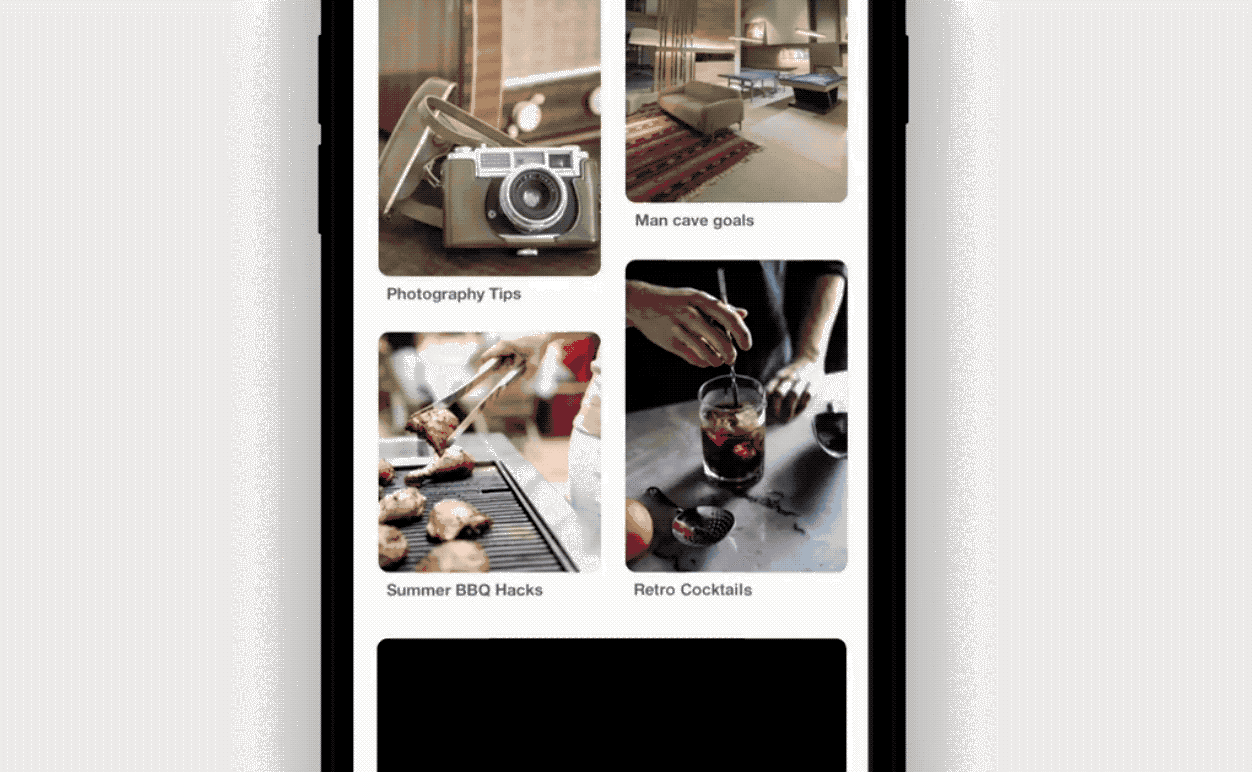
Carousel ads
Carousel ads feature multiple images that users can swipe through. Each card within the carousel can include its own image, title, description and landing page, making this the ideal ad format for showcasing product ranges or campaigns targeting a wide audience. Carousel ads are available for brand awareness, consideration and conversions campaign objectives.
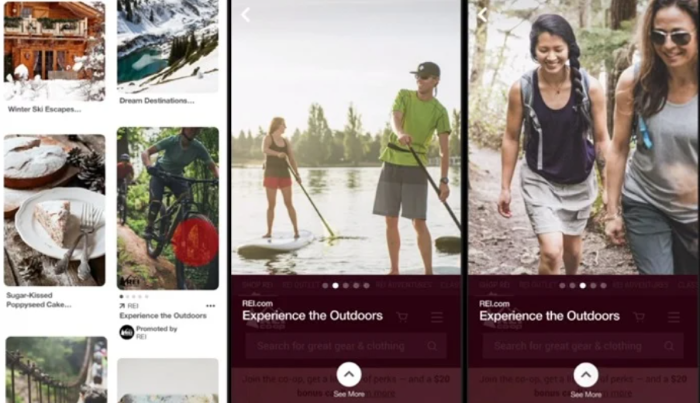
Shopping ads
Shopping ads feature one image or a video at a time and allow people to purchase products they find on Pinterest. To run shopping ads, you’ll need to create a product catalogue containing all of your product data and this ad format is only available for the catalogue sales campaign objective.
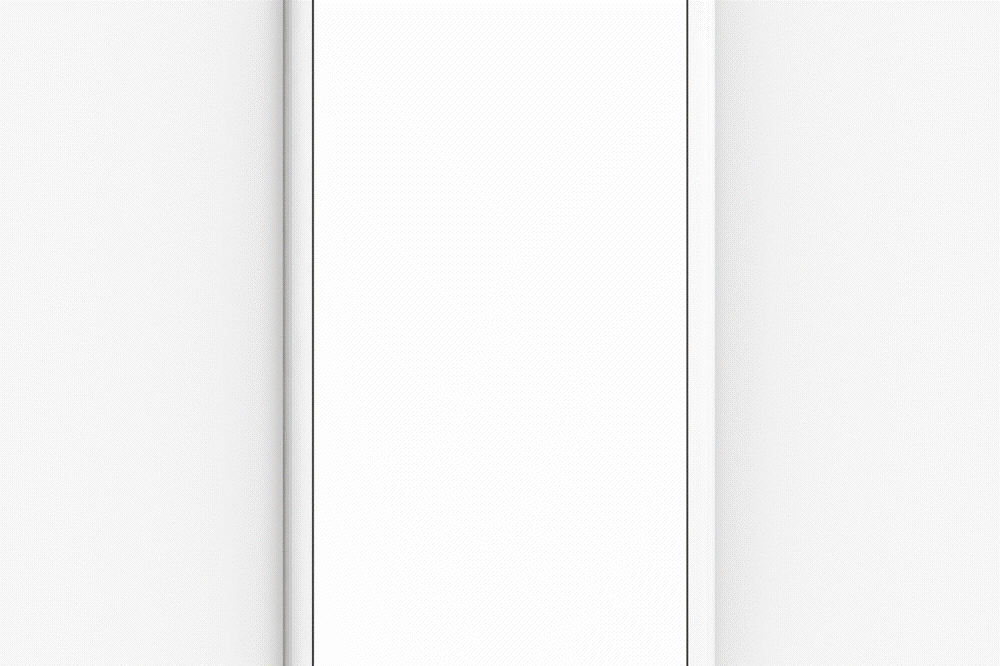
Collections ads
Collections ads appear as one main image above three smaller images in feeds on mobile devices. When a user clicks on a collections ad, they’re shown a full-screen feed where they can scroll through up to 24 secondary creatives, allowing you to showcase extensive product ranges and related items. Collections ads are available for all campaign objectives, except for video views.

3. How much does it cost to advertise on Pinterest?
This is always a tricky question to answer for social advertising because there are so many factors at play. Pinterest is even more complex than most networks, too, due to the fact it’s a hybrid discovery platform and search engine, complete with keyword targeting options.
Generally speaking, though, Pinterest CPCs cost more than Facebook but less than Instagram, which puts it roughly in the middle of the road. A common figure for average Pinterest CPCs is $ 1.50 but this is an arbitrary figure because you’re going to pay far less for some clicks and far more for others.
Keep in mind that the more expensive clicks are often the more profitable ones and be careful about using CPCs as a measure of expense when comparing social networks. It’s far more important to look at what you’re getting in return for your spend and Pinterest has a big advantage here in its highly engaged user base. This is the only major network where users are explicitly looking for purchase inspiration, which is an invaluable characteristic for advertisers.
4. Are Pinterest ads effective?
Pinterest was built as a platform for people to search, browse, discover and buy products. The innate consumer purpose of the platform means that ads integrate seamlessly into the experience, which isn’t something most social networks can say. In fact, Pinterest ads enhance the experience because they help users to do precisely what they want from the platform: to find products.

In the past, the network has published data suggesting as many as 90% of weekly Pinners make purchase decisions on the network. This is a big deal because your ads aren’t interrupting the user experience; they’re a natural part of it. The only thing standing in your way is getting your ads seen by the most relevant audience and Pinterest has a natural flair for this, too. The search aspect of the platform means you can target keywords that target specific interests and purchase intentions.
Pinterest doesn’t rely on keyword targeting alone, though. The platform has developed a capable system of targeting options to help you pinpoint the right audience across search and discovery sessions:
- Demographics: Narrow in on the right audience using information like age, gender, location and language.
- Interests: Reach people based on the topics that they like, such as recipes or home décor. Your ads will display as people browse their home feeds.
- Keywords: Reach people that are ready to act by targeting specific search terms. Your ads will appear in search results and related Pins.
- Customer lists: Upload your customer list to reach people who have already engaged with your website, shop or Pinterest content.
- Actalikes: Use Actalike audiences to find other people with similar interests and behaviours to your existing customers.
- Automated targeting: Pinterest picks your audience based on details from your Pin (we recommend manual targeting but this can be good if you’re in a rush to launch campaigns).
With a user base that’s primed to discover and buy products, combined with a comprehensive set of targeting features, Pinterest is an effective advertising platform. Let’s put it this way: if your target audiences are using this network, then you better be as well.
5. How to advertise on Pinterest
If you’ve made it this far through our guide, you must be pretty confident that Pinterest is an advertising platform worth investing in. So, in this section, we explain how you can set up an advertising account on the network and create your first campaign.
#1: Create your Pinterest For Business account
To start advertising on Pinterest, you’ll need a Pinterest For Business account and you can create yours by visiting this signup page.
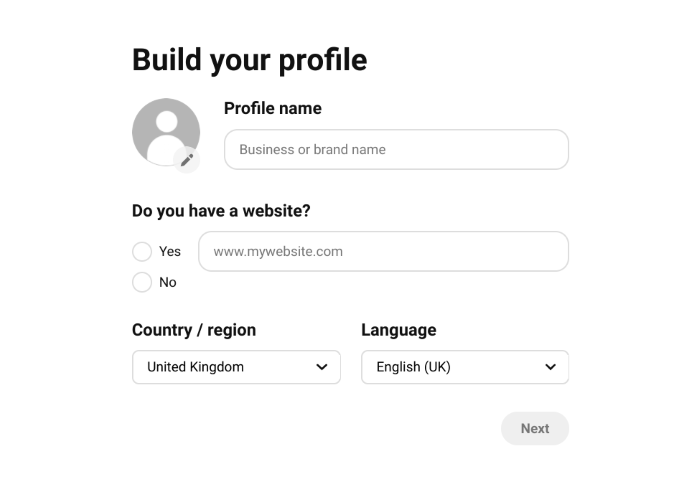
Type in your business name and website URL (if you have one) and click the Next button to move on to the next step. In the following interface, you’ll be asked to describe your business and the dropdown list provides a good indication of the kind of businesses that should be advertising on Pinterest:
- Beauty
- Fashion
- Home
- Travel
- Food and drink
- DIY and craft
- Health and fitness
- Education
- Design and art
- Events
If none of those apply, you can select Other from the dropdown list and don’t be discouraged if your business type isn’t listed. As mentioned above, this is a platform for targeting consumers and creatives, many of whom are small business owners, creatives and affluent professionals with interests more diverse than the list above – so don’t feel that you can advertise on Pinterest just because you’re a SaaS company or a consumer electronics brand.
Once you’ve described your business, you can select up to three advertising goals from the following six options:
- Sell more products
- Generate more leads for your business
- Drive traffic to your site
- Create content on Pinterest to grow an audience
- Grow brand awareness
- Not sure yet
Don’t worry if you’re not sure about your goals at this point, your answers simply help Pinterest provide personalised recommendations. Once you’ve made your selection, follow the remaining prompts and you’ll have your account set up in 2-3 minutes.
#2: Build your business profile
Once you’ve created your Pinterest For Business account, you’ll be taken through an optional onboarding process.
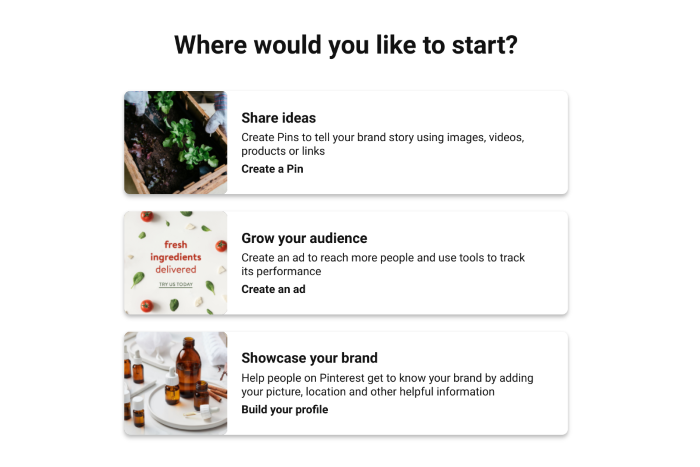
You can skip this if you want but we recommend you start by selecting the Showcase your brand tab, which encourages you to build your business profile. There’s not much point in running ads until your profile is complete and audiences can see that you’re a legitimate business.
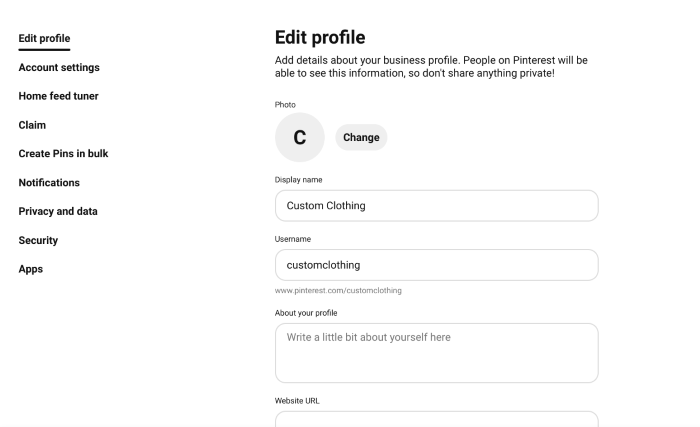
On the edit profile page, you can add a profile photo, edit your display name and change your username. You can also write about your business, enter your website URL and provide your email address and phone number if you want users to be able to see this. If you’ve got a physical business location, you can also add your address and show this to users. Complete as much of your profile as you can and click the Save button.
#3: Create your first Pins
It’s also a good idea to publish some organic Pins on your account before you start advertising. This allows you to tell your brand story and build a bit of a profile on the network before you start putting ads in front of people’s faces.
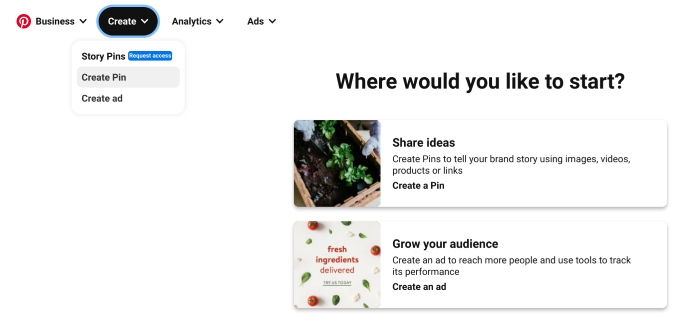
From the onboarding screen, you can select the Share ideas tab or you can click Create from the top-left navigation menu and select Create Pin to get started.
Here’s some advice directly from Pinterest on how to create your first Pin and these tips all apply to creating ads, too:
- Pick a vertical image: Use high-quality, vertical images that will stand out in people’s feeds. We recommend a 2:3 aspect ratio (e.g. 1,000 x 1,500 pixels). Other ratios may cause your Pin to truncate, or may negatively impact performance.
- Make your brand the focal point: Put your product or service front and centre. Avoid using abstract images or lifestyle imagery that doesn’t showcase your brand.
- Include your logo: Put a logo on every Pin you make, but keep it subtle. Avoid the lower-right corner, since that spot gets covered up by our product icons.
- Add text overlay: Text overlay is the copy that goes on your Pin image to make it stand out. Keep your copy concise for readability on mobile. You should create separate Pins for each country you target, so they can be translated into the local language.
- Optimise your Pin copy: Clear titles and descriptions help your Pin get discovered in search. You can use up to 100 characters for your title and up to 500 characters for your description.
- Check your links: If your Pin includes a link, check that the link is active and loads quickly. Your Pin’s creative tells people what to expect when they click. Make sure it matches your destination site’s topic and imagery.
You’ll want to publish organic Pins regularly to build your brand’s presence on Pinterest and prove to users that you’re a valuable part of the community. Although Pinterest users are generally more receptive to ads, thanks to the inspirational nature of the platform, they’re not going to respond well if you turn up and just start shoving ads in front of faces.
#4: Install the Pinterest tag on your website
To track user behaviour on your website after they click through from your Pinterest ads, you need to place the Pinterest tag in the <head> tags on every page you want to track.
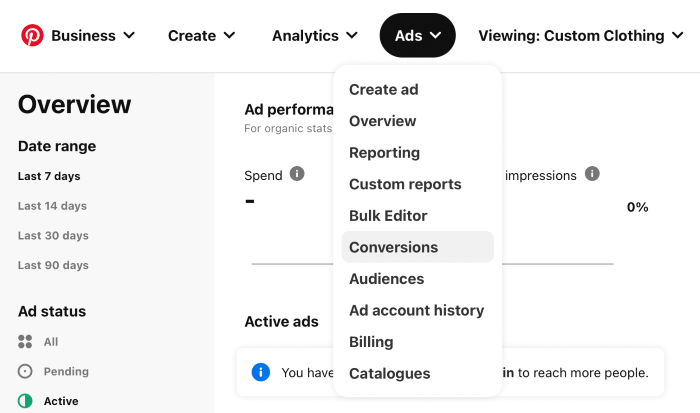
In Pinterest For Business, click on Ads and then select Conversions from the drop-down menu to access the base code. Under the Install your Pinterest Tag section, you’ll see three options for installing your tag.
Select the Add code button under Add code to website.
This will bring up the base code you need to install on your website. Click the Copy code button and add this to every page where you want to track conversions.
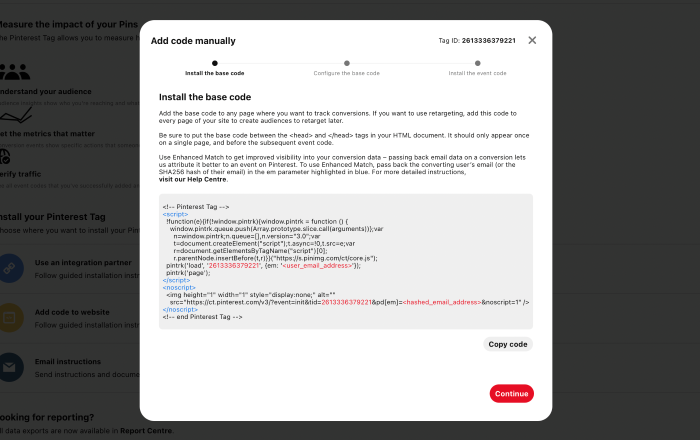
Once you’re done, go back to the tag installation tool in Pinterest For Business and click the Continue button. On the following page, you’ll be asked to name your tag and then, which is set as “Pinterest Tag” by default and then you can click Install tag. This will take you to the events code page where you can copy and install events tracking codes for the events shown below:
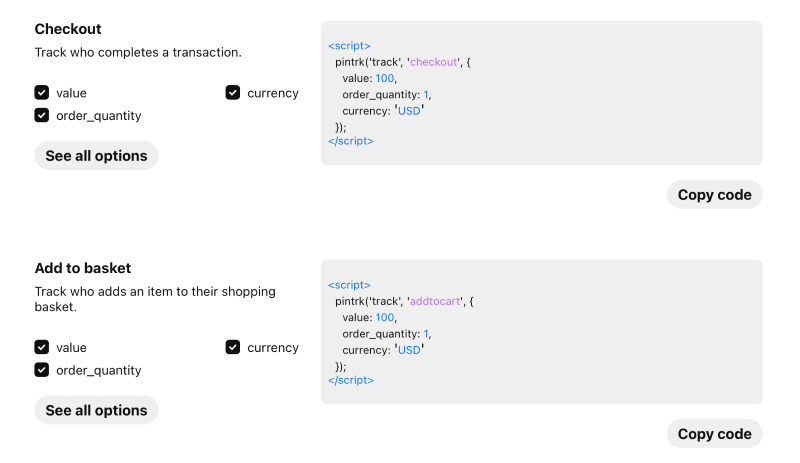
- Checkout: Track who completes a transaction.
- Add to basket: Track who adds an item to their shopping basket.
- Page visit: Track who visits primary pages, such as product or article pages.
- Sign-up: Track who signs up for your products or service.
- WatchVideo: Track who watches your videos.
- Lead: Track who shows interest in your product or service.
- Search: Track who performs searches on your website to look for specific products or store locations.
- Viewcategory: Track who views category pages.
- Custom: Track a custom event that you want to include in your conversion reporting.
- User-defined events: Name your own event to use for audience targeting.
Pinterest pre-selects the recommended data points to track for each event but you can click See all options to make your own selections. When you’re happy, hit the Copy code button and add each snippet to every page where you want to track each event.
#5: Create your first Pinterest campaign
Before you create your first Pinterest ad, you need to set up a campaign by clicking Ads > Create ad in the main navigation within Pinterest For Business.
First up, you’ll need to select your campaign objective from the following five options:
- Brand awareness
- Consideration (formerly traffic)
- Conversions
- Video views
- Catalogue sales
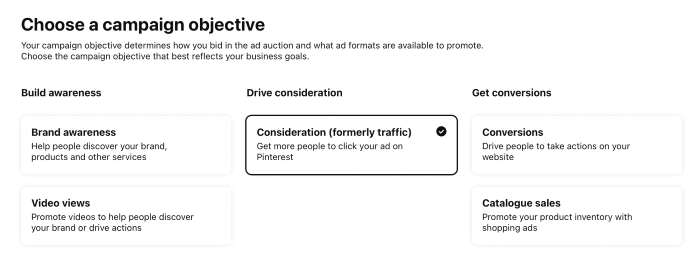
The setup process varies for each campaign objective but you’ll be guided through every step, whichever one you choose. You can also click the Campaign spend limits and status (optional) tab to limit the daily and lifetime spend of your campaign and set the campaign to Active or Paused.
#6: Create your first ad group
With your campaign set up, you can now create your first ad group. Once again, you’ll be asked to name your ad group and, then, you need to define your targeting settings, which are broken down into the following five steps:
- Select a strategy
- Audience lists
- Keywords & interests
- Demographics
- Ad placement
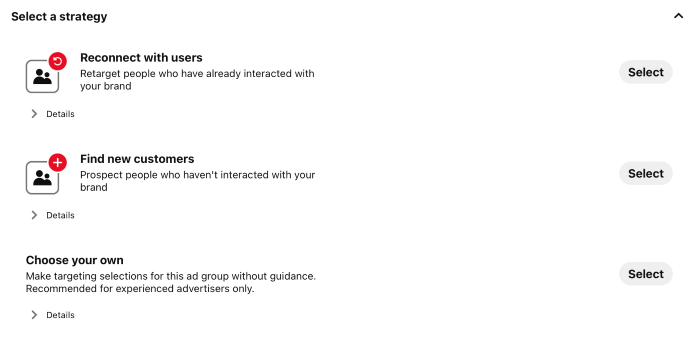
Pinterest automatically suggests ad group strategies based on the campaign objective you selected earlier. As we chose Brand awareness, Pinterest suggests using either the Reconnect with users to retarget users or Find new customers to reach a wider audience. As this is our first ad group, it makes sense to go with Find new customers but you can also choose your own targeting strategy by clicking the Select button under Choose your own.
Once you’ve completed the targeting details section, you want to set a maximum budget for your ad group and you can either define a daily or lifetime budget (daily is strongly recommended). In the Ad group schedule section, you can also set your ad group to run continuously or select a start and end date for short or seasonal ad groups.
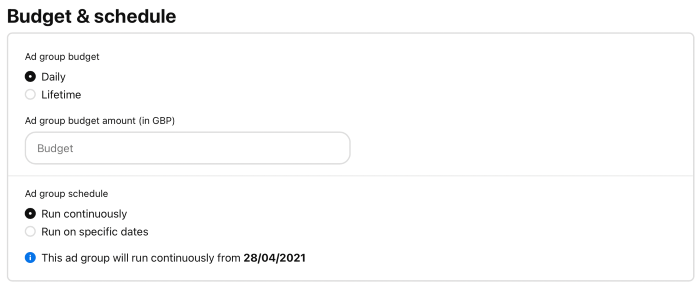
#7: Create your first ad
With your campaign and ad group set up, you’re finally ready to create your first ad. Pinterest shows all of the ad formats available for your campaign type and, in our case, regular pins are the only option available for brand awareness.
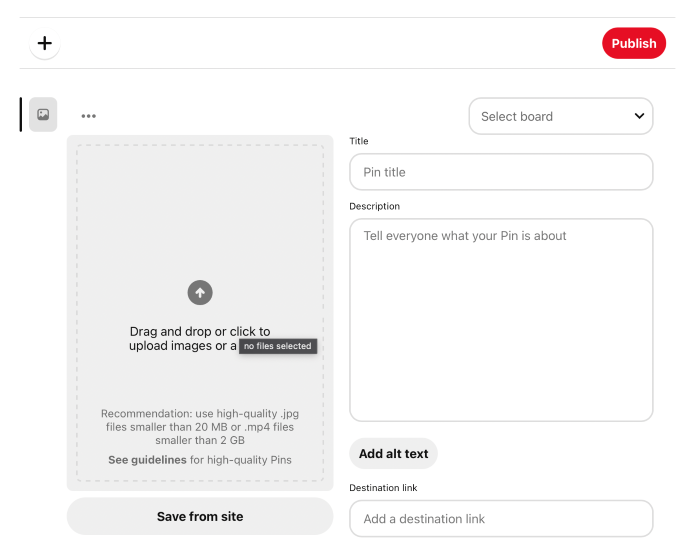
You’ll need to upload at least one vertical image or video, create a Pin title and add a description to explain what your Pin is about. You also have to select a board to home your Pin (all Pins must be added to a board) and it’s recommended to add alt text to describe the content in your image or video. Finally, add a destination link and hit the Publish button to launch your campaign.
6. Pinterest advertising best practices
Now that you’re up and running with Pinterest advertising and your first campaign is live, let’s round things up by looking at some best practices to help you get the best results from the platform.
- Become a visual content producer: Pinterest is all about visual content and engagement so you’re going to need professional-grade images and video for every campaign.
- Become a storyteller: Your aim is to inspire purchase decisions and nothing is more inspiring than a story that stirs the emotions of your target audience.
- Post ad-free content: Show users that you’re a valuable part of the community by regularly posting ad-free content, too.
- Engage with others: Interact with other users on the platform, especially non-competitors who might attract the attention of your target audience.
- Keep it relevant: Make everything you do on Pinterest relevant to your brand (and target audience) even when you’re posting ad-free content and engaging with others.
- Keep it authentic: Be as strategic as you can but make sure your content and interactions are authentic and believable.
- Bid accordingly: Pinterest users are engaged and actionable so don’t be afraid to up those bids to take full advantage.
- Find what works: Test targeting settings and bids to find a long-term strategy that works for your brand.
- Nurture leads: The first ad click doesn’t always win the sale so place lead capture strategies on your website and use the Pinterest tag to target previous visitors with relevant messages to bring them back.
Need help with your Pinterest advertising?
Pinterest has built a capable advertising platform over the years, playing on its natural strengths as a product discovery and consideration tool. It’s a smaller, more niche user base than you get from the likes of Facebook and Instagram but it’s more engaged and receptive to product promotion than any other network.
Business & Finance Articles on Business 2 Community
(71)
